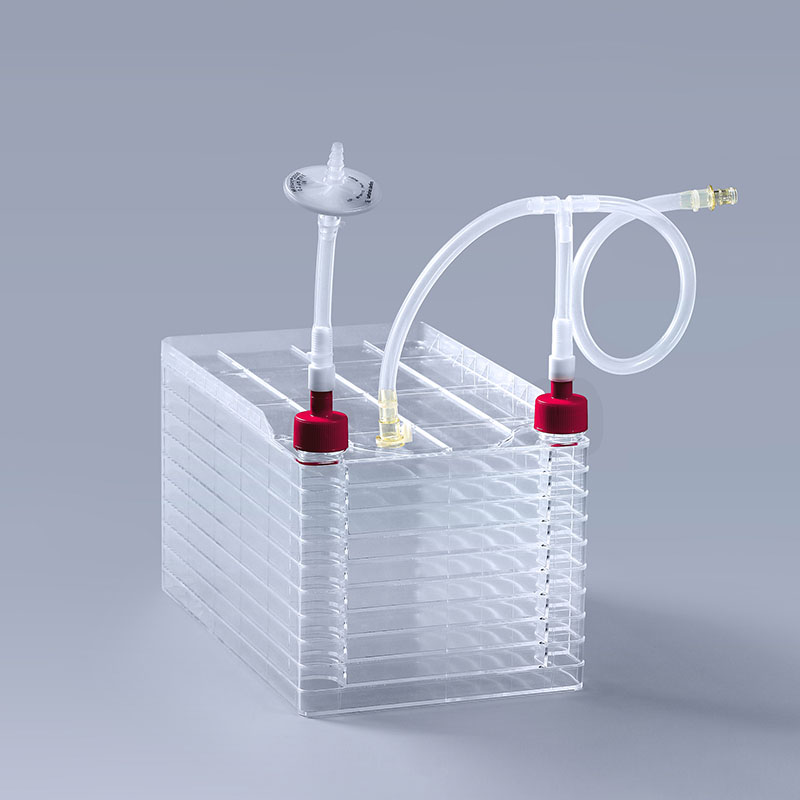In the sterile cleanroom of a biopharmaceutical facility, a precise cell seeding ritual is underway at the cell factory workstation. A technician, wielding a pipette, is inoculating precious Vero cells into a 40-layer cell factory—each movement determining the success or failure of this batch of raw materials for COVID-19 vaccines. Seeding density, a seemingly simple parameter, is in fact the most delicate balance to strike in cell culture processes.
Selecting the optimal seeding density is an exact science. Take the commonly used HEK293 cells as an example: in a 1-layer cell factory, the ideal seeding density typically hovers around 3×10^4 cells/cm². This number isn’t arbitrary—it’s a golden midpoint validated through countless experiments. If the density is too low, cells grow sluggishly due to insufficient paracrine signaling; if too high, they prematurely deplete nutrients, leading to growth inhibition. In a 10-layer cell factory, this parameter must be adjusted downward by 5–10% to account for reduced oxygenation in the lower layers due to the multi-tiered structure.

Different cell lines have distinct "preferences" for seeding density. CHO cells, like solitary artists, thrive at a relatively sparse 2×10^4 cells/cm² to achieve efficient antibody expression. Meanwhile, MRC-5 human fetal lung fibroblasts resemble social team players, requiring up to 5×10^4 cells/cm² to kickstart optimal proliferation. These differences stem from variations in growth factor requirements and contact inhibition thresholds among cell lines. A skilled process developer must understand these traits as intimately as they know an old friend.
Calculating seeding density requires consideration of vessel characteristics. When transitioning from T-175 flasks to a 5-layer cell factory, a simple area-based proportional conversion won’t suffice. The deep structure of cell factories alters the fluid dynamics of the medium, typically necessitating a 15–20% increase in seeding volume to compensate for gas exchange differences in deep-layer cultures. Modern biopharmaceutical companies maintain specialized seeding parameter matrices for each cell-vessel combination—a core part of their proprietary know-how.
In practice, adjusting density is akin to playing a musical instrument. Experienced technicians fine-tune each seeding based on growth curves from previous generations. If cells enter the plateau phase too early in the third generation, they’ll slightly reduce the density for the fourth; if the lag phase is prolonged, they’ll increase the next seeding by 5%. This dynamic optimization ensures every batch of cells enters the production phase in peak condition.
From vaccine development to gene therapy, cell factories are driving biopharmaceuticals into a new era of scaled production. Mastering the art and science of seeding density is the critical bridge that transforms these advanced therapies from lab discoveries to industrial realities. Every cell count, precise down to the last digit, paves the way for a future where more patients can be healed.
The FAI climbed 5.9 percent year-on-year in the first 11 months of 2018, quickening from the 5.7-percent growth in Jan-Oct, the National Bureau of Statistics (NBS) said Friday in an online statement.
The key indicator of investment, dubbed a major growth driver, hit the bottom in August and has since started to rebound steadily.
In the face of emerging economic challenges home and abroad, China has stepped up efforts to stabilize investment, in particular rolling out measures to motivate private investors and channel funds into infrastructure.
Friday's data showed private investment, accounting for more than 60 percent of the total FAI, expanded by a brisk 8.7 percent.
NBS spokesperson Mao Shengyong said funds into weak economic links registered rapid increases as investment in environmental protection and agriculture jumped 42 percent and 12.5 percent respectively, much faster than the average.
In breakdown, investment in high-tech and equipment manufacturing remained vigorous with 16.1-percent and 11.6-percent increases respectively in the first 11 months. Infrastructure investment gained 3.7 percent, staying flat. Investment in property development rose 9.7 percent, also unchanged.
 English
English


















































